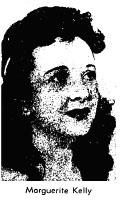 September 1, 1947
September 1, 1947West Hollywood
Yesterday, Marguerite Kelly’s apartment door, at 1334 Olive Drive just off the Sunset Strip, was framed with fragrant honeysuckle. Today, the County Coroner defaced it with a sticker meant to seal the contents until her next of kin could be notified.
Marguerite, 29, was a blues chanteuse who never quite made it. After seven years in Hollywood, her small trust fund was nearly depleted and occasional cafe gigs weren’t replenishing it. Her longtime friend Charles T. Young, 59-year-old retired market exec, took her out to fancy dinners, but seemed disinterested in making things more permanent. She began making notes to herself, analyzing her sad situation.
So after one such evening out with Mr. Young, Marguerite topped off the champagne cocktails with a shot of gas from the stove. Arriving the next morning, Young smelled rotten eggs mixed with the floral vines. With the aid of apartment manager W.J. Ferry, he forced the triple-locked and bolted door.
Inside lay Marguerite, nude, tangled in her blankets, nearly dead. Beside her, a note to Young, calling him the greatest man in the world. It begged “don’t cut my hair, just cremate me.”
Young expressed surprise that his ladyfriend had felt so strongly for him, and suggested that had he known, he might have done something about it. Too late now. She died and was taken to Utter-McKinley mortuary.
Marguerite has a sister in Milwaukee who may come and claim her sheet music and other remnants of life in Los Angeles.
Suggested reading: Hollywood Babylon : The Legendary Underground Classic of Hollywood’s Darkest and Best Kept Secrets

and Militarily on Alert
Combat Veterans Wear Blue as Backbone of
Force Los Angeles Builds to Succeed Older Men
They are building a new, young, military Police Department for Los Angeles these days with the men who helped to win the war on foreign battlefields and in the sky making up its backbone.
Already there are more than 1,000 new police officers who once were G.I.’s An additional 1,175 are authorized by the City Council.
“We’re going to have a young and strong Police Department,â€Â Joseph F. Reed, assistant chief of police, said yesterday, “but it will take us at least five years to make professional career officers of the same caliber as the older and more experienced men who gradually are attaining retirement age.â€Â
+ + +
The Times focused on four men: Sgt. Johnny Williams of the Navy, a Silver Star recipient who was an instructor at the Police Academy; Leland Schmidt of the Marines, wounded at Saipan and Iwo Jima, who was a traffic accident investigator; Dick Funkhouser, a B-17 pilot who spent six months at Stalag Luft No. 1 and was a motorcycle officer; Larry Toole, an Army Air Forces pilot who was walking a beat in skid row; and George Audet, an Army engineer, who became a motorcycle officer.
The influx of so many veterans made a powerful transformation in the LAPD in terms of discipline, attitude and professionalism. (Recruits received extra points on their entrance exams for military service). But many officers, especially in later years, complained that it was run too much like the military, especially in terms of community relations.
In addition, the returning veterans forced the department to either absorb or dismiss many “Wartime Emergencyâ€Â officers who were hired under relaxed standards. Like most employers, the department was required to hire men who had left for military service, but there was wide sentiment in the community for retaining those who had served in their absence and it was years before some hard feelings were dispelled.
The Times failed to mention another returning veteran, former Army Capt. William H. Parker, who was appointed to the rank of inspector as head of the Traffic Division in 1947.
https://www.lmharnisch.com
The “Hollywood Babylonâ€Â books are terrible, little more than cultural artifacts presenting history as bitchy gossip, owing a profound and unacknowledged debt to John Austin’s obscure paperback “Hollywood’s Unsolved Mysteries.â€Â The similarity between Austin’s book (1969-1970) and “Hollywood Babylon 2â€Â (1984) on the Black Dahlia case is far too strong for coincidence. See my website’s “Cut and Paste Clubâ€Â for more details.
https://www.lmharnisch.com